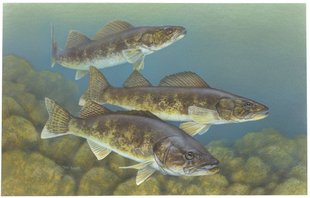Walleye
|
|
| Walleye | ||||||||||||||
|---|---|---|---|---|---|---|---|---|---|---|---|---|---|---|
 | ||||||||||||||
| Scientific classification | ||||||||||||||
| ||||||||||||||
| Binomial name | ||||||||||||||
| Sander vitreus (Mitchill, 1818) |
- This article is about the fish; for the terms related to the eye, see Iris (anatomy) and Strabismus.
A North American relative of the European pikeperch, the walleye or yellow pike (Sander vitreus, formerly Stizostedion vitreum) is a freshwater perciform fish native to most of Canada and the northern United States; it is believed to be an introduced species in the mid-Atlantic states. A genetical unique strain is known to inhabit the Mobile River Basin. The common name walleye comes from the fact their eyes, not unlike cats, reflect light in a unique fashion. Their eyes allow them to see very well in low-light conditions. In fact, many fisherman look for walleyes at night since this is when most major feeding patterns occur. Their eyes also allow them to see well in turbid water (rough, breaking water on mid-lake reefs) which gives them an advantage over their prey. Thus walleye fisherman will commonly look for days and locations where there is a good "Walleye Chop" (i.e. rough water).
Walleye may grow to one metre (3 feet) in length, and weigh up to 11 kilograms (25.5 pounds). The dorsal side of a walleye is olive in colour, and is broken up by five dark saddles that extend to the upper sides. The olive color shades to white on the belly. The mouth of a walleye is large, armed with many sharp teeth. Both the first dorsal and anal fin are spinous. What distinguishes walleye from its close cousin the sauger is the white on the lower tip of the tail.
The walleye requires relatively pristine waters and is most often found in deep water in large, clear, cool lakes and rivers. It migrates to tributary streams in winter and spring to lay eggs in sand or gravel bars. A large female can lay up to 495,000 eggs and no care is given by the parents to the eggs and fry. The young walleyes eat invertebrates while the adults eat fishes (particularly yellow perch and freshwater drum), moving onto bars and shoals at night to feed. A walleye may live for 29 years or more.
The walleye is often considered to have the best tasting flesh of any freshwater fish, and as such is fished recreationally and commercially. Because of its nocturnal feeding habits it is most easily caught at night using live minnows, or lures that mimic small fishes.
The walleye is the state fish of Minnesota.
